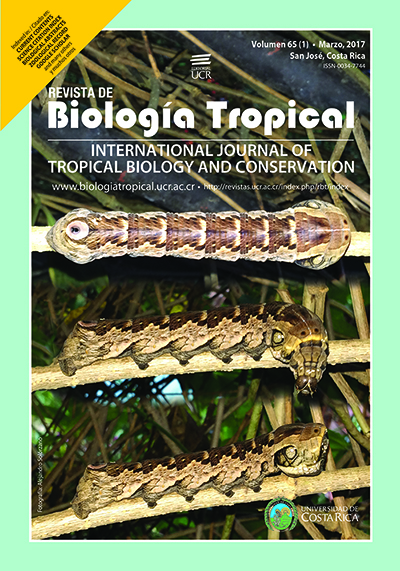Resumen
En México se han registrado 29 especies del género Amnestus, de las cuales, seis se encuentran en el estado de Veracruz. Se describen e ilustran las características morfológicas de los estadios inmaduros de A. rugosus, incluyendo notas sobre su biología y comportamiento. Las ninfas y adultos fueron recolectados en los remanentes de la vegetación riparia del bosque mesófilo en la cuenca del río La Antigua, Veracruz. El muestreo se realizó en la zona montañosa del centro del estado y en la parte media de la cuenca. Se seleccionaron 12 sitios ubicados en cinco municipios, y se realizaron muestreos en época de lluvias (julio) y en secas (abril); las muestras fueron procesadas en embudos de Berlese-Tullgren y Winkler. Se recolectaron y revisaron 419 ejemplares, 320 adultos y 99 ninfas de A. rugosus. El tamaño y coloración del cuerpo y los patrones de puntuación son las principales diferencias entre los estados inmaduros de A. rugosus, A. ficus y A. morelensis. A. rugosus representa un nuevo registro para Veracruz.
Citas
Billberg, G. J. (1820). Enumeratio insectorum in museo. Stockolm, Sweden: G. J. Billberg.
Eger, J. E. (2008). A new genus and three new species of burrowing bugs (Hemiptera: Heteroptera: Cydnidae: Amnestinae). Proceedings of the Entomological Society of Washington, 110(4), 940-947.
Froeschner, R. C. (1960). Cydnidae of the Western Hemisphere. Proceedings of the United States National Museum, 111(3430), 337-680.
Granados-Sánchez, D., Hernández, M., & López-Ríos, G. (2006). Ecología de zonas ribereñas. Revista Chapingo, Serie Ciencias Forestales y del Ambiente, 12(1), 55-69.
Grazia, J., Schuh, R. T., & Wheeler, W. C. (2008). Phylogenetic relationships of family groups in Pentatomoidea based on morphology and DNA sequences (Insecta: Heteroptera). Cladistics, 24, 932-976.
Mayorga, M. M. C., & Cervantes, P. L. (2001). Life cycle and description of a new species of Amnestus Dallas (Hemiptera-Heteroptera: Cydnidae) associated with the fruit of several species of Ficus (Moraceae) in Mexico. Journal of the New York Entomological Society, 109(3-4), 392-402.
Mayorga, M. M. C. (2002). Revisión genérica de la familia Cydnidae (Hemiptera-Heteroptera) en México, con un listado de las especies conocidas. Anales Instituto de Biología, Universidad Nacional Autónoma de México, Serie Zoológica, 73(2), 157-192.
Mayorga, M. M. C., & Cervantes, P. L. (2005). Description of six new species of Amnestus Dallas (Hemiptera-Heteroptera: Cydnidae) from Mexico. Journal of the New York Entomological Society, 113(3-4), 159-173.
Mayorga, M. M. C., & Cervantes, P. L. (2006). Cydnidae (Hemiptera: Heteroptera) del Centro de Investigaciones Costeras La Mancha, Actopan, Veracruz, México. Revista Mexicana de Biodiversidad, 77, 205-214.
Mayorga, M. M. C., & Cervantes, P. L. (2014). Immature stages of Pangaeus (Pangaeus) serripes (Westwood) (Hemiptera-Heteroptera: Cydnidae: Cydninae), associated with figs in Mexico. Studies on Neotropical Fauna and Environment, 49(1), 36-40.
Mayorga, M. M. C. (2015). Una especie nueva de Amnestus (Hemiptera: Heteroptera: Cydnidae) de Morelos, México, con descripción de sus estados inmaduros. Revista Mexicana de Biodiversidad, 86, 912-915.
McColloch, J., & Hayes, W. (1922). The reciprocal relation of soil and insects. Ecological Society of America, 3(4), 288-301.
Menke, A. (1979). The semiaquatic and aquatic Hemiptera of California (Heteroptera: Hemiptera). Bulletin of the California insect survey, 21, 163.
Naiman, R., & Décamps, H. (1990). The ecology and management of aquatic-terrestrial ecotones. Man and Biosphere Series, 4. Parthernon, UNESCO.
Panizzi, A. R., & Grazia, J. (2015). True Bugs (Heteroptera) of the Neotropics. Vol. 2. Brazil: Springer.
Robins, J., & Cain, J. (2002). The past and present condition of the Marsh Creek watershed. Berkley, CA: Natural Heritage Institute.
Schuh, R., & Slater, J. (1995). True bugs of the World (Hemiptera: Heteroptera), Classification and Natural History. New York, USA: Cornell University Press.
Sites, R. W., & McPherson, J. (1982). Life history and laboratory rearing of Sehirus cinctus cinctus (Hemiptera: Cydnidae), with description of immature stages. Annals Entomology Society American, 75, 210-215.
Southwood, T. R. (1949). Some notes on the early stages and biology of Sehirus bicolor (L.) (Hemiptera: Cydnidae). The Entomologist's monthly magazine, 85, 39-41.
Strahler, A. (1964). Quantitative geomorphology of drainage basins and channel networks. En V. Chow (Ed.). Handbook of applied hydrology. New York, USA: Mc Graw-Hill.
Taylor, S., & McPearson, J. (1998). Laboratory rearing of Mesovelia cryptofila (Heteroptera: Mesoveliidae). Entomological News, 109(2), 95-98.
Tsukamoto, L., & Tojo, S. (1992). A Report of Progressive Provisioning in a Stink Bug, Parastrachia japonensis (Hemiptera: Cydnidae). Journal of Ethology, 10, 21-29.
Tullgren, A. (1918). Ein sehr einfacher Ausleseapparat fuAr terricole Tierfaunen. Zeitschrift Fur Angewandte Entomology, 4, 149-50.
Villareal, H., Álvarez, M., Córdoba, S., Escobar, F., Fagua, G., Gast, F., … Umaña, A. (2004). Manual de métodos para el desarrollo de inventarios de biodiversidad. Programa de inventarios de la Biodiversidad. Colombia: Instituto Alexander von Humboldt.
Vivan, L., Nardi, C., Grazia, J., & Bento, J. (2013). Description of the immatures of Scaptocoris carvalhoi Becker (Hemiptera: Cydnidae). Neotropical Entomology, 42(1), 121-125.
##plugins.facebook.comentarios##

Esta obra está bajo una licencia internacional Creative Commons Atribución 4.0.
Derechos de autor 2017 Revista de Biología Tropical






